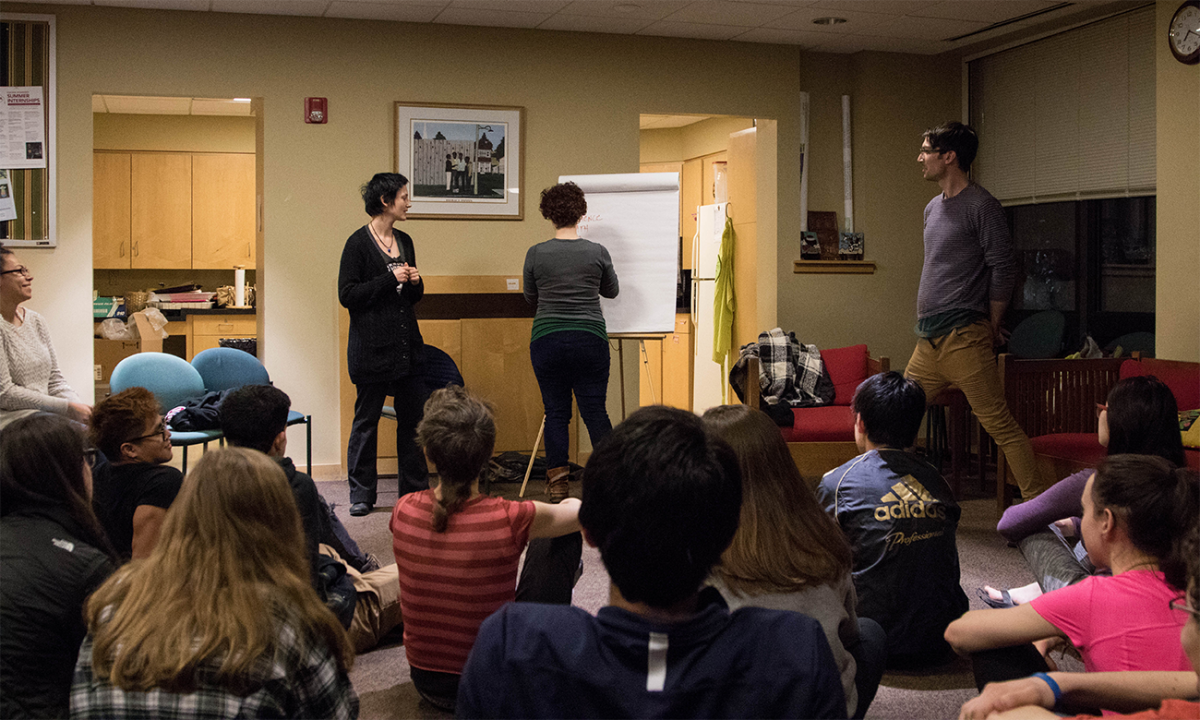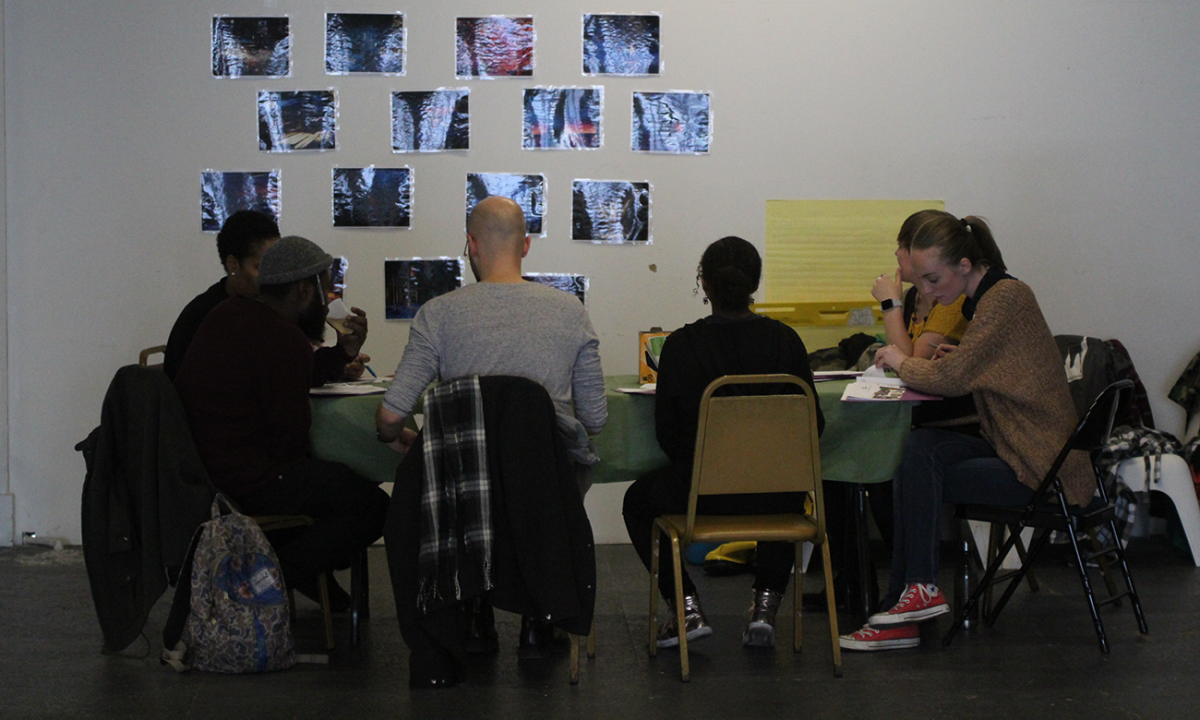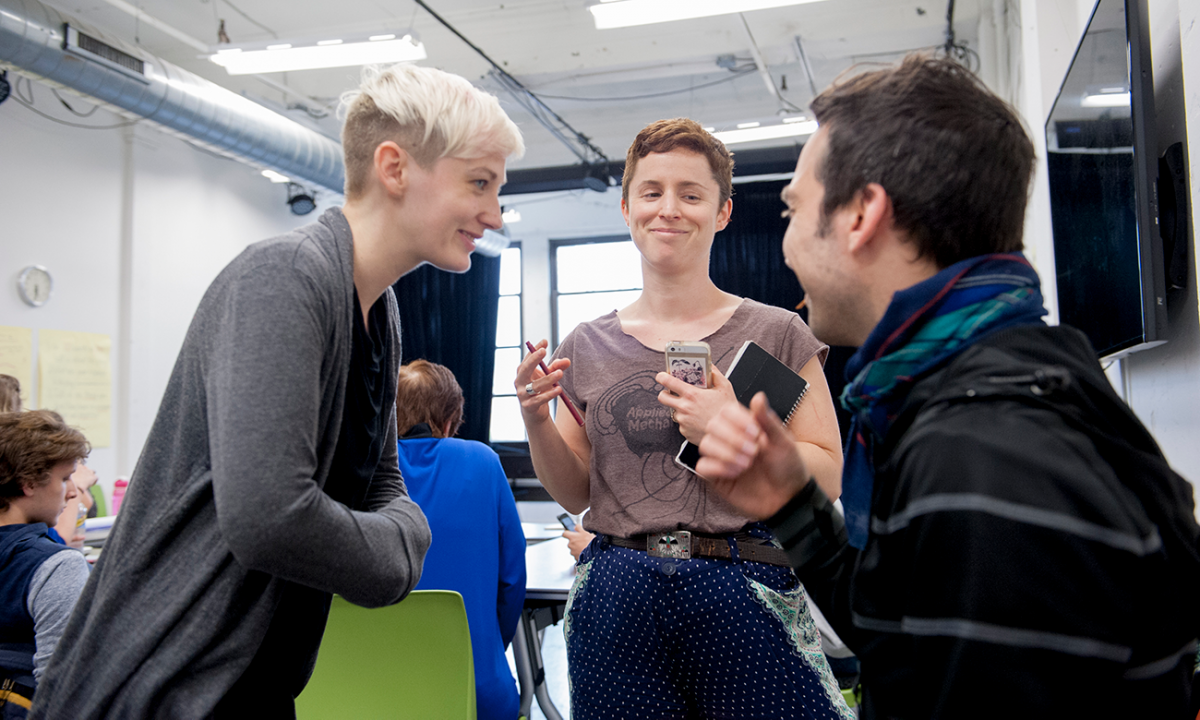How to Model a Healthier Professional Culture That Benefits Marginalized Artists and Administrators
Carl(os) Roa offers thoughts on how organizations can create healthier workspaces, weaving in ideas from artists at Philadelphia Young Playwrights and Applied Mechanics.
I’ve been obsessed with the nearly inexplicable sensations I feel whenever I walk into a rehearsal space, a production shop, or the offices of a non-profit theatre company. As someone who has been freelancing, organizing, and creating performance art in Philadelphia, I have come to believe that all professional spaces have their own spirit or aura that’s informed by how the organization treats their people.
Sometimes, the aura is one of fraught anxiety. It is reflected in the body language of beleaguered arts administrators who just can’t be bothered to speak to anyone, in the passive-aggressive snub of a top-tier Equity actor in town, in the way some production workers communicate aggressively towards stagehands and front-of-house workers. Of course, without transformational experiences to offset this kind of drudgery, I would’ve quit a long time ago. I speak not as someone who has had a lot of negative incidents, but as someone who viscerally remembers the affirming ones.
“Why does it actively hurt to work in some places?” I have asked myself. “And why doesn’t it hurt to work in others?” I wanted to know what the organizations behind the positive spaces were doing that made me feel valued, respected, and like my presence mattered. How have these places reinvented what professionalism means under the confines of the non-profit industrial complex?

I grew up in a Colombian-Haitian household where expectations towards etiquette and communication were radically different from those of the Northeastern elite. I came to realize that my resistance to the professional norms I encountered—like punctuality, punitive action, and hierarchy—came from a place of frustration against these Western cultural norms, norms that negatively impact artists of color. When institutions continue to operate under the model of top-down hierarchical structures that uphold whiteness and Eurocentric thought, the lone administrator of color in the office or the rehearsal room is most affected.
These professional norms were being prescribed against my own in the face of an arts scene that is deficient in cultural equity and inclusion—the very same equity and inclusion that the arts need in order to be seen as relevant in 2019. Most of this has already been written about by other activists, but there are a few key dynamics at play I want to look at that affect artists across all axes of oppression: The values of scarcity over abundance. The promotion of self over the celebration of others. The desperate grab for resources over the comfort of knowing there’s always enough for everyone. And, most importantly, micromanagement over trust.
If institutions want to work better to support artists from marginalized backgrounds, the following elements need to be considered.
Boundaries, Compensation, Time, and Space to Grow
As a younger freelancer trying to discover my own way of being, a big learning curve for me was the establishment of my own boundaries and the ability to advocate for myself. I don’t just mean the nitty-gritty of not working for free or for too many hours, but making sure that if there was a difference in core values between me and a collaborator—whether an individual or a company—a conversation about it was possible.
These conversations were not easy to have, and, in fact, not all institutions were open to having them in the first place, or even respecting the boundaries that I set. Of course, in a capitalist society where non-profits are pressured to function similarly to corporations, I can’t say I am too surprised. But not everywhere is like that.

I’ve been working with Philadelphia Young Playwrights (PYP), an arts education organization with a distinct interest in trauma-informed practice, for the past two years. Every day I walk into that office, even as an assistant teaching apprentice, I feel like my work has an impact and is respected.
Najja Zimele-Keita, PYP’s development and communications coordinator, believes that the best way to help young people is to listen to them and see what they need. “A lot of times,” he says, “young people just need to be given the space to do what they need to do without people micromanaging them or treating them like they aren’t going to have the wherewithal to follow through.”
Part of a non-profit’s job in nurturing a healthier climate also means communicating the organization’s needs, like being upfront about how many hours a job will take. Respecting a freelancer’s limits is something else an organization can do. Far too often, when a new job is posted for a non-profit arts position, there’s a certain degree of sugarcoating that happens in the description. Twenty hours a week actually means thirty; part-time actually means full-time. When this happens, the morale a new hire has to begin with chips away slowly, which can lead some workers to wonder if they actually want to be there.
The most basic litmus test for assessing office climate in any institution is at staff meetings, which are notorious in many administrative settings for being a tedious waste of time or an oppressive opportunity to highlight a department’s shortcomings. But staff meetings can also be inspirational. If time is well spent and if the room is imbued with an attitude of appreciation, workers will always feel valued and respected. At PYP, staff meetings are often the highlight of the week—a space where people can not only share business updates but also where they can commiserate over their personal lives. (And, most importantly, it’s when the office dogs visit.)
A conversation about how organizations can be better also needs to cover compensation. One crucial way a company can show they value their employees’ time and expertise is by prioritizing a proper wage above the art. However, sometimes that’s not possible. Applied Mechanics, a radical theatre collective based in Philadelphia, believes that if organizations don’t have a huge amount of money to compensate people, they need to provide their artists with home-cooked meals or to share decision-making power in order to make their collaborators feel taken care of and valued. According to Rebecca Wright, one of the members, this will ensure that people keep showing up and doing the work and, on top of that, allow the work to feel meaningful.
“When questions of professionalism come up, a big dividing line is: are you getting paid for your work or not?” says Wright. “People really use that to point to whether or not you’re professional, which is problematic in and of itself, and definitely speaks to certain values.”
There are a myriad of ways to create a sense of respect and value among a team of employees—and, for marginalized professionals especially, the incentive needs be about something far greater than surviving the gig economy for just another couple of months.

Dismantling Hierarchies
The typical non-profit theatre model leans on a simple (and outdated) formula: There’s an artistic director, who is often the major determinant for the artistic shape of the institution. There’s a managing director, who keeps the administrative staff focused on their tasks, which are mostly isolated from the art itself. Then there’s the administrative staff and contract workers, who are almost always subject to the whims of upper management. I have been in too many rooms like these, where I was made to feel as if my voice didn’t matter or that the leadership viewed my contributions and perspective as secondary to theirs. I felt far too powerless, and I was hungry to learn from folks who were doing something different.
The Applied Mechanics collective operates under a socialist cooperative producing model, where leadership and labor is shared amongst the collective as a whole. Every member is paid the same amount, with the exception of an administrator who is paid more due to the position having a greater focus on labor rather than artistic collaboration.
Talking to Wright and Thomas Choinacky, another member of the group, led to some interesting reflections on what it means to give time to an institution or a collective. It felt significant that the company began as a group of working artists who were willing to work for free in the name of a shared vision and in a space where decisions about process, production, and planning are made democratically.
When hierarchy is eschewed in favor of unity, voices that aren’t normally heard suddenly come to light, forming an artistic process that allows for unique ideas. True consensus might be impossible under this model (the same for any others, for that matter), but the parties involved at least know their opinions and choices matter.
“If the ask is ‘I want everyone’s voice to be heard’ then you have to make a space where people want to contribute their voices,” says Wright. “The ‘everyone’s voice being heard’ thing, in addition to being a value, is also an aesthetic.”
Wright described Applied Mechanics’ immersive performances as being polyphonic: because many voices come together to mount the projects, the art that ensues can only be characterized as a collective vision, never the machinations of a single auteur.
Thinking back to the rooms where I’ve felt the fraught anxiety, perhaps it was because the environment had very little to do with the art—that the progressive and even intersectional values shown in the productions were completely at odds with how leadership and administration behaved to their fellow professionals and freelancers.
When executive director Lisa Nelson-Hayes began her tenure at PYP in 2016, she noticed there was a very distinct line between the programmatic staff and the administrative staff. Her leadership style is highly collaborative, and she worked to eliminate the divide. “I’m always floored by how you never know where you’re going to get a fabulous idea,” she said.
The collaborative structure suddenly becomes one that benefits underrepresented artists who are used to finding a backdoor entrance to an institution.

Belief Systems, and Why the Work Gets Done
Belief systems struck me as one of the most vital components of PYP’s infrastructure as an arts education non-profit, and, by extension, one of the most vital components other arts organizations can adopt to create healthier professional cultures.
PYP’s office environment is a reflection of what can happen when there’s a shared vision rather than a singular one. On any given day, a variety of teaching artists, staff members, and administrators walk through the door—people from various backgrounds and with various work styles. At no point is anyone ever pressured to perform administrative tasks with machine-like precision and, in fact, the incongruity of professional styles within the organization is celebrated.
“At other organizations you bring yourself to fit into the culture, whereas here, we as our individual selves make this culture,” says Mindy A. Early, PYP’s director of education and programs services. “It’s not like we’re all becoming the same personality or the same perspective.”
Nelson-Hayes adds that PYP is an organism that’s alive, that morphs and that’s reactive towards whatever forces they’re faced with. “I want us to constantly be proactive and progressive in our thoughts,” she says. “How we are functioning internally will be reflected in how we function with the constituents we serve.”
The organic makeup of a staff directory needs to mirror the very people they’re intended to benefit. In this vein, ideas are more important than institutions, and, above all else, people are more important than ideas.
It’s clear that the professionals who work with both PYP and Applied Mechanics show up not just because they’re being compensated, but because they actually care about the overall vision of the institution—to the point where they even feel like masters of their own destiny in the confines of their shared world. These organizations hold a tenacious belief in the power of their own people, and, in turn, believe that the cultures that make up these groups needs to be heterogeneous, not homogenous.
What I have taken from those kernels of truth is that organizations must have the audacity to replicate these ideas so that rehearsal spaces, production shops, and offices don’t have those negative auras of anxiety and, instead, have ones that are warm and welcoming—especially for marginalized workers. Now more than ever, institutions must make a choice to either model a healthier professional culture or fade into irrelevance.
This article was originally published on Howlround on the 1st of May 2019. Read the original article.
